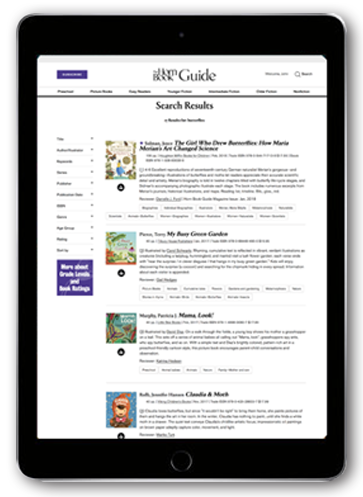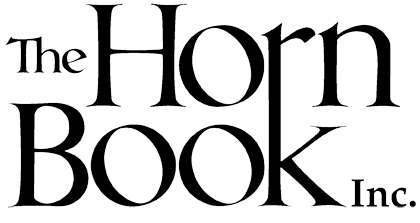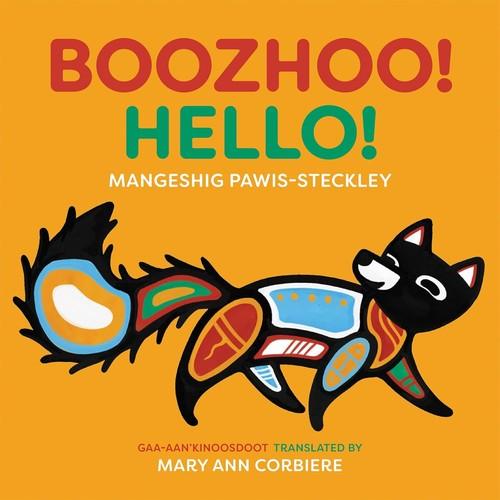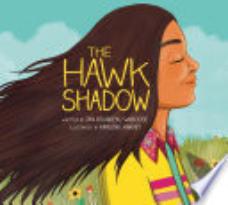Native Americans--North America--Anishinaabe
11 Reviews
(2)
K-3
Illustrated by
Aly McKnight.
A young girl and her family eagerly prepare for and take part in the Jingle Dress dance, an Anishinaabe tradition established during the 1918 1919 influenza pandemic. Havrelock's (Saddle Lake Cree Nation) straightforward text incorporates vivid sensory imagery ("buckles shine, beads glimmer"; "Mom's warm fingers slide through my hair") and realistic details ("Everyone gets a big shot of hair spray!"), and evokes both the contemporary and the traditional while capturing the narrator's excitement. McKnight's (Shoshone-Bannock) colorful watercolor and graphite illustrations focus on the family and the regalia, and include such details as the different colors of black in a girl's braids; the variety of Indigenous people's hair colors and textures; the jingles on dresses that sway so convincingly you can almost hear them; and a red handprint covering the mouth of a woman watching the dance, signifying her solidarity with Missing and Murdered Indigenous Women, Girls, and Two-Spirit People. Back matter gives more information about this century-old ritual of healing and thanks, including its significance in the wake of COVID-19 with its devastating effect on Native communities. A moving portrayal of how Jingle Dress dancers "dance for those who can't."
(2)
PS
Illustrated by
Erin Hill.
During the car ride to celebrate Christmas on the Rez, Baby asks questions that Mommy and Daddy patiently answer, sharing Anishinaabe customs and beliefs. Once they arrive, Baby tells their grandparents, Kookum and Mooshom, what they learned: "we are all family"; "it is good to give things away"; "home is where we come from." Hill's digital illustrations feature a loving Native family proud of their culture. An endnote explains the relationship between traditional Anishinaabe winter solstice observances and the adopted holiday of Christmas.
Reviewer: Kitty Flynn
| Horn Book Magazine Issue:
November, 2024
(2)
K-3
Illustrated by
Kristy Cameron.
Renowned Indigenous storyteller Locke (Lakota and Anishinabe) provides an engaging retelling of a Lakota legend. Wakhán Thánka (the Great Spirit) creates the world in seven days. After sending power to the East, South, West, and North, Wakhán Thánka creates mountains, trees, plants, animals, and water. On day five, the ancestors are put into motion in Grandfather Sky; on day six, Grandmother Earth receives the gift of creation. Finally, on the seventh day, Wakhán Thanka makes the greatest gift: the human spirit. But where to put it? Buffalo, Bear, and other animals have ideas, but in the end Wakhán Thánka places it at the center of all. "The intersection of everything in this universe, this creation, is within each one of us. We have the responsibility to guard this precious gift as it does not belong to us but to Wakhán Thánka." Locke's lively text and Cameron's (Métis) brightly colored and textured stylized illustrations bring a dynamism to the tale. A list of Lakota words in the text is appended.
Reviewer: Nicholl Denice Montgomery
| Horn Book Magazine Issue:
May, 2024
(3)
PS
Translated by Mary Ann Corbiere.
Employing the time-tested baby book refrains “What do you see?” and “What do you hear?”, Pawis-Steckley’s (Ojibwe) upbeat text takes readers along for a stroll in the morning woods, introducing them to thirteen different animals engaged in everyday activities like munching leaves, climbing a tree, digging a hole, and eventually falling asleep. Written in Anishinaabemowin and English and featuring bright, varicolored, minimalist woodland-style illustrations, this is a welcome addition to Native American literature for the preschool set. Includes bilingual author’s and translator’s notes.
Reviewer: Summer Edward
(3)
K-3
Illustrated by
Karlene Harvey.
As Serenity, an Anishinaabe girl, follows her brother Big Ed to the river to fish, she connects with the medicine and spirits of nature, including the hawks who are their protectors. When Big Ed gets into a pinch while fishing, Serenity rescues him with a red-tailed hawk’s help. Waboose’s (Nishnawbe Ojibway) ecologically conscious text skillfully balances moments of suspense and lightheartedness and reflects the dynamics of a healthy sibling relationship. Harvey’s (Tsilhqot'in/Syilx) full-color digital illustrations capture the moods and personalities of the characters.
Reviewer: Summer Edward
(2)
K-3
Illustrated by
Bridget George.
Lindstrom (We Are Water Protectors, rev. 7/20; My Powerful Hair, rev. 3/23) introduces the mission of contemporary Indigenous water activist Autumn Peltier and her great-aunt, the late Josephine Henriette Mandamin (both Anishinaabe). The lyrical text, narrated by water itself ("I am nibi. I have a spirit. I have feelings. I remember"), is effective in its simplicity and highlights the belief that water is a living thing that needs us to "Speak for the water. Sing for the water. Dance for the water." Grandma Josephine ("as she was lovingly known") recognized the harmful effects of water pollution in the Great Lakes, and she took action. To raise awareness, she walked around the lakes carrying water in a copper pail and united women from other Indigenous communities--now known as the Mother Earth Water Walkers--to join the water protection movement and inform government leaders. "When Grandma Josephine journeyed on to the spirit world, Autumn...began to use her voice for me." The colorful, flowing illustrations beautifully reflect and depict the nature of water. Peltier provides the book's foreword; back matter includes more detailed information about Grandma Josephine's and Autumn's accomplishments, a glossary, and resources to "keep learning."
(1)
K-3
Translated by Mary Ann Corbiere.
Illustrated by
Joshua Mangeshig Pawis-Steckley.
A lyrical text written in Anishinaabemowin and English tells about the journey of a seed and of an ecosystem. "A seed is a story you can hold in your hand." The mnoomin seed travels first in the waterways, where it remembers Mayfly, who fed Pike, "who in turn nourished the earth below"; Eagle, who makes sure Muskrat does not eat "more than the field could bear"; and Moose, who "uproots crowding plants" by walking through the water. When the seeds sprout in the water, their leaves provide hiding places for small fish and protection for Duck and her ducklings on shore. Luby's reverent text then describes the traditional method of harvesting what grows. The winnowed grains are danced upon, washed, roasted, and eaten. Some are stored, and some sown for future harvest. Pawis-Steckley's vibrant color palette captures the hues of sunlight throughout the story as well as the lush flora and fauna and the warmth of the human interactions. Notes about the balance of the ecosystem and about the book's use of language are appended.
 Luby, Brittany
Luby, Brittany
Mii maanda ezhi-gkendmaanh / This Is How I Know: Niibing, dgwaagig, bboong, mnookmig dbaadjigaade maanpii mzin'igning / A Book about the Seasons
(2)
PS
Translated by Alan Corbiere.
Illustrated by
Joshua Mangeshig Pawis-Steckley.
A child and their grownup experience the seasons together in this bilingual (Anishinaabemowin and English) picture book. The text follows a question-and-answer pattern. Each query rests on a double-page spread with loads of white space and a visual clue signaling the response to come. In the first spread, for example, a zoomed-in image of three blueberries rests on the verso page, while the following text appears on the recto: "Aaniish ezhi-gkendmaanh niibing? / How do I know summer is here?" The responses to each question include visceral, sensory-rich descriptions of how each season is experienced through the characters' observations and absorption into the natural world ("Pii pinion gaa-giizhiwaabidegin mgising / gzhaawngideg gewe negwiki." / "When blueberries drop readily, / and the sand is hot enough to sting"). Throughout, the gray-haired character is shown taking care of the child by preparing food, mending footwear, and more. The digital art, with its jewel tones and thick black outlines, at times resembles stained glass. Other spreads feature shadows and gradients beautifully depicting the aurora borealis, sunsets over water, and calming rays of winter sunshine streaming through a bedroom window. A warmhearted depiction of the seasons and intergenerational closeness.
Reviewer: Elisa Gall
| Horn Book Magazine Issue:
July, 2021
(3)
K-3
Illustrated by
François Thisdale.
After Uncle scares cousins Tom and Will with the story of the Windigo (known to Anishinaabe peoples as the night spirit of winter), they follow what they think are its tracks; instead they find a young moose trapped in the snow and help to free it. Subdued-color art with hidden animal tracks evokes the dark, north-country winter setting in this not-too-scary Anishinaabe tale of respect for nature.
Reviewer: Bridget McCaffrey
(3)
K-3
Illustrated by
Gillian Newland.
The author shares a story based on her grandmother Irene's experience in an Indian residential school in Ontario, Canada. Taken away from her family, Irene suffers emotional trauma and abuse at the hands of Christian missionaries. Featuring powerful watercolor and ink illustrations, a straightforwardly told first-person narrative of resistance and strength. Author's note included.
Reviewer: Alia Jones
(3)
K-3
As explained in the author's note, Anishinaabe people believe in totem animals, clans that exemplify certain traits. Daniel, who is Métis, created this small, unusual book to teach her son about his culture and to encourage others to learn about their own clans. Soft acrylic paintings showing children in stylized animal masks appear opposite four-line poems focusing on each totem's character traits.
Reviewer: Melinda Greenblatt
11 reviews
We are currently offering this content for free. Sign up now to activate your personal profile, where you can save articles for future viewing.














